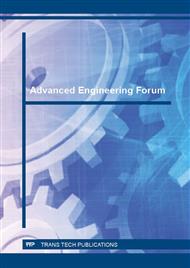[1]
ACI 325. 10R-95(2000), State-of-the-art report on roller-compacted concrete pavements, ACI Manual of Concrete Practice, ACI, USA. 32 pp.
DOI: 10.14359/9760
Google Scholar
[2]
ACI 211 3R-02(2002), Guide for Selecting Proportions for No Slump Concrete.
Google Scholar
[3]
Atis, C. D. (2002). High volume Fly Ash abrasion resistant concrete. Journal of Materials in Civil Engineering, 14(3), 274-277. http: /dx. doi. org/10. 1061/(ASCE)0899-1561(2002)14: 3(274).
DOI: 10.1061/(asce)0899-1561(2002)14:3(274)
Google Scholar
[4]
Atiş, C. D., & Celik, O. N. (2002). Relation between abrasion resistance and flexural strength of high volume Fly Ash concrete. Materials and Structures, 35(4), 257-260. doi: 10. 1007/BF02533087.
DOI: 10.1007/bf02533087
Google Scholar
[5]
Bonicelli, A., Giustozzi, F., & Crispino, M. (2015).
Google Scholar
[6]
Dhadse, S., Kumari, P., & Bhagia, L. J. (2008). Fly Ash characterization, utilization and Government initiatives in India-A review. J. Sci. Ind. Res, 67(1), 11-18. http: /nopr. niscair. res. in/handle/123456789/724.
Google Scholar
[7]
Dong, Q., Wu, H., Huang, B., Shu, X., & Wang, K. (2010).
Google Scholar
[8]
Gaedicke, C., Marines, A., & Miankodila, F. (2014). Assessing the abrasion resistance of cores in virgin and recycled aggregate pervious concrete. Construction and Building Materials, 68, 701-708. doi: 10. 1016/j. conbuildmat. 2014. 07. 001.
DOI: 10.1016/j.conbuildmat.2014.07.001
Google Scholar
[9]
IS: 383 (1970), Specification for Coarse aggregate and Fine aggregate from Natural Sources for Concrete, Bureau of Indian Standard, New Delhi.
Google Scholar
[10]
IS: 4031(1980), Methods of Physical Test for Hydraulic Cement – Determination of Consistency of Standard Cement Paste, Bureau of Indian Standard, New Delhi.
Google Scholar
[11]
IS: 456(2000), Code Practice for Plain and Cement Concrete, Bureau of Indian Standard, New Delhi.
Google Scholar
[12]
IS: 1727(1967), Methods of test for pozzolanic materials, Bureau of Indian Standard, New Delhi.
Google Scholar
[13]
IS: 516(1959), Methods of tests for strength of concrete, Bureau of Indian Standard, New Delhi.
Google Scholar
[14]
Kumar, G. R., & Sharma, U. K. (2014). Standard test methods for determination of abrasion resistance of concrete. International Journal of Civil Engineering Research, 5(2), 155-162. http: /www. ripublication. com/ijcer_spl/ijcerv5n2spl_09. pdf.
Google Scholar
[15]
Neville, A. M., & Brooks, J. J. (1987). Concrete technology. Harlow: Longman Scientific & Technical. http: /worldcat. org/isbn/0582988594.
Google Scholar
[16]
Naik, T. R., Singh, S. S., & Ramme, B. W. (2002). Effect of source of Fly Ash on abrasion resistance of concrete. Journal of Materials in Civil Engineering, 14(5), 417-426. http: /dx. doi. org/10. 1061/(ASCE)0899-1561(2002)14: 5(417).
DOI: 10.1061/(asce)0899-1561(2002)14:5(417)
Google Scholar
[17]
Naik, T. R., Singh, S. S., & Hossain, M. M. (1995). Abrasion resistance of high-strength concrete made with class C Fly Ash. ACI Materials Journal, 92(6). http: /worldcat. org/oclc/13846872.
DOI: 10.14359/9785
Google Scholar
[18]
NTPC report Fly ash for Cement Concrete, http: /www. ntpc. co. in/ash-download/1674/0/fly-ash-cement-concrete-%E2%80%93-resource-high-strength-and-durability-structure-lower-cost.
DOI: 10.14359/18723
Google Scholar
[19]
Rao, S.K., P. Sravana, Rao T.C., (2013) Mix Design of Roller Compacted Concrete: An experimental study Using Crushed Stone and River Sand as Fine Aggregate, National Conference on SCMAT, NIT Warangal.
Google Scholar
[20]
Rao, S.K., P. Sravana, Rao T.C., (2015).
Google Scholar
[21]
Rao, S.K., P. Sravana, Rao T.C., (2015).
Google Scholar
[22]
Rao, S.K., P. Sravana, Rao T.C., (2015).
Google Scholar
[23]
Siddique, R. (2004). Performance characteristics of high-volume Class F Fly Ash concrete. Cement and Concrete Research, 34(3), 487-493. doi: 10. 1016/j. cemconres. 2003. 09. 002.
DOI: 10.1016/j.cemconres.2003.09.002
Google Scholar
[24]
Siddique, R., Kapoor, K., Kadri, E. H., & Bennacer, R. (2012).
Google Scholar
[25]
Siddique, R. (2003). Effect of fine aggregate replacement with Class F Fly Ash on the abrasion resistance of concrete. Cement and concrete research, 33(11), 1877-1881. doi: 10. 1016/S0008-8846(02)01000-1.
DOI: 10.1016/s0008-8846(03)00212-6
Google Scholar
[26]
Shi, Z. Q., & Chung, D. D. L. (1997). Improving the abrasion resistance of mortar by adding latex and carbon fibers. Cement and Concrete Research, 27(8), 1149-1153. doi: 10. 1016/S0008-8846(97)00097-5.
DOI: 10.1016/s0008-8846(97)00097-5
Google Scholar
[27]
Shu, X., Huang, B., Wu, H., Dong, Q., & Burdette, E. G. (2011).
Google Scholar
[28]
Takada, Y., Nakayama, E., Sasaki, K., Suzuki, T., Mori, S., & Kamada, O. (2015).
Google Scholar
[29]
Yen, T., Hsu, T. H., Liu, Y. W., & Chen, S. H. (2007). Influence of class F Fly Ash on the abrasion–erosion resistance of high-strength concrete. Construction and Building Materials, 21(2), 458-463. doi: 10. 1016/j. conbuildmat. 2005. 06. 051.
DOI: 10.1016/j.conbuildmat.2005.06.051
Google Scholar
[30]
ASTM C 131- Standard Test Method for Resistance to Degradation of Small-Size Coarse Aggregate by Abrasion and Impact in the Los Angeles Machine, ASTM International.
DOI: 10.1520/c0131-01
Google Scholar
[31]
ASTM C 1747- Standard Test Method for Determining Potential Resistance to Degradation of Pervious Concrete by Impact and Abrasion, ASTM International.
DOI: 10.1520/c1747_c1747m
Google Scholar
[32]
ASTM C944 (2012), Standard test method for abrasion resistance of concrete or mortar surfaces by the rotating-cutter method, ASTM International.
DOI: 10.1520/c0944_c0944m-99r05e01
Google Scholar


